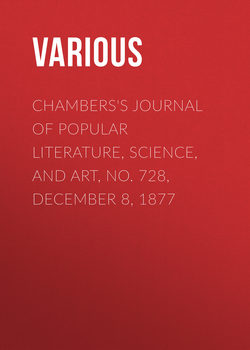Chambers's Journal of Popular Literature, Science, and Art, No. 728, December 8, 1877

Реклама. ООО «ЛитРес», ИНН: 7719571260.
Оглавление
Various. Chambers's Journal of Popular Literature, Science, and Art, No. 728, December 8, 1877
THE HIDDEN BOX. A TALE OF THE COVENANTERS
FIRES AND THEIR CAUSES
A CAST OF THE NET. THE STORY OF A DETECTIVE OFFICER
SEA-LIONS
ANCIENT STREETS AND HOMESTEADS OF ENGLAND
JAPANESE FANS
THE PIXIES
Отрывок из книги
The oft-repeated words, 'Cause unknown,' appended to the daily reports of the conflagrations which occur all over the country – such as that, for instance, which lately occurred at Inveraray Castle, but which is now supposed to have been caused by lightning – furnish matter for grave reflection. A glance at the report of one of the largest fire brigades will shew us that the causes (when ascertained) are of the most varied description. It appears that the candle is the most destructive weapon to be found in an ordinary household, for conflagrations lighted by its help far outnumber those credited to any other cause. Curtains come next on the black list. The next large figures are given to 'Spark from fire,' followed by 'Foul flues.' Next in order may be noticed 'Gas,' 'Children playing with fire,' 'Tobacco-smoking,' 'Spontaneous ignition,' and lastly 'Incendiarism.'
There is no doubt that many a fire owes its origin to causes quite beyond the control of the tenant of the house in which it occurs, and that the scamping manner in which builders' work is often done is the prime cause of many a fire which is put down as unaccounted for. The ends of joists are left protruding into chimneys, or a thin hearthstone is set upon a bed of timber. In both cases the wood becomes so dry and hot that it is ready to take fire from the first spark that settles near it. Overheated flues represent a source of danger which is also attributable to the careless builder; for if the flue were so placed that its heat could not affect adjacent woodwork, it would be always as safe when hot as when cold. It is true that by act of parliament builders are obliged to preserve a certain distance between flues and timber; but surveyors cannot always reckon on their instructions being carried out, and cases are unfortunately rare nowadays where workmen will do their duty in such matters without constant supervision. Lath and plaster divisions between houses are also illegal; but buildings, and more especially warehouses, are now of such vast extent, that they really represent aggregations of small houses in which the act of parliament concerning party-walls becomes a dead-letter.
.....
There is no doubt that many a fire owes its origin to causes quite beyond the control of the tenant of the house in which it occurs, and that the scamping manner in which builders' work is often done is the prime cause of many a fire which is put down as unaccounted for. The ends of joists are left protruding into chimneys, or a thin hearthstone is set upon a bed of timber. In both cases the wood becomes so dry and hot that it is ready to take fire from the first spark that settles near it. Overheated flues represent a source of danger which is also attributable to the careless builder; for if the flue were so placed that its heat could not affect adjacent woodwork, it would be always as safe when hot as when cold. It is true that by act of parliament builders are obliged to preserve a certain distance between flues and timber; but surveyors cannot always reckon on their instructions being carried out, and cases are unfortunately rare nowadays where workmen will do their duty in such matters without constant supervision. Lath and plaster divisions between houses are also illegal; but buildings, and more especially warehouses, are now of such vast extent, that they really represent aggregations of small houses in which the act of parliament concerning party-walls becomes a dead-letter.
Among the ascertained causes of fire are those which occur in the various workshops where hazardous trades are carried on. These naturally shew an increase since steam-power has become such a universal aid to nearly every kind of human labour; necessitating furnaces which remain kindled for weeks or months together. Apart from this source of risk, there are numerous trades where such inflammables as turpentine, naphtha, spirits of wine, and combinations of them in the form of varnishes, are in daily use to a very large extent. The familiarity which such constant use provokes breeds a contempt which often resolves itself into a negligence almost criminal in its nature. Drying-stoves afford another dangerous item in the list of fires connected with the trades; japanners, cabinet-makers, and hosts of others using such stoves as a necessity of their business. Hot-water pipes for heating purposes also represent the cause of a large number of fires, the most dangerous kind being those which are charged with water and hermetically sealed. The reason of this is easily explained. Water boils at a temperature far below that necessary to ignite woodwork; but when confined in such pipes as we have described, it will rise in temperature to an extent only measured by the strength of the material which holds it. A soft metal plug is sometimes inserted in these pipes, so that should any unusual degree of heat be approached, it will melt out, and thus relieve the pressure; but such a good precaution is by no means universal.
.....